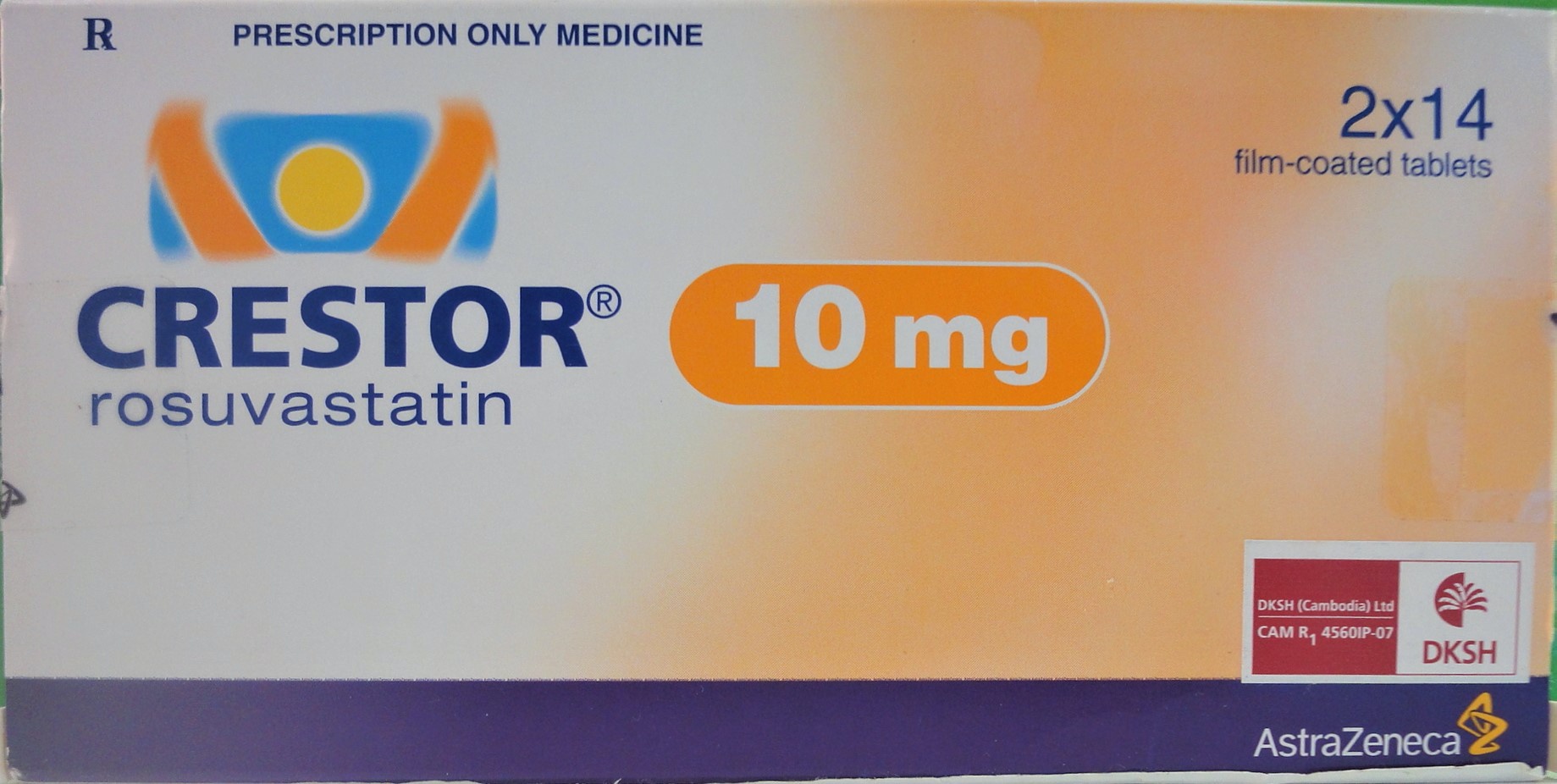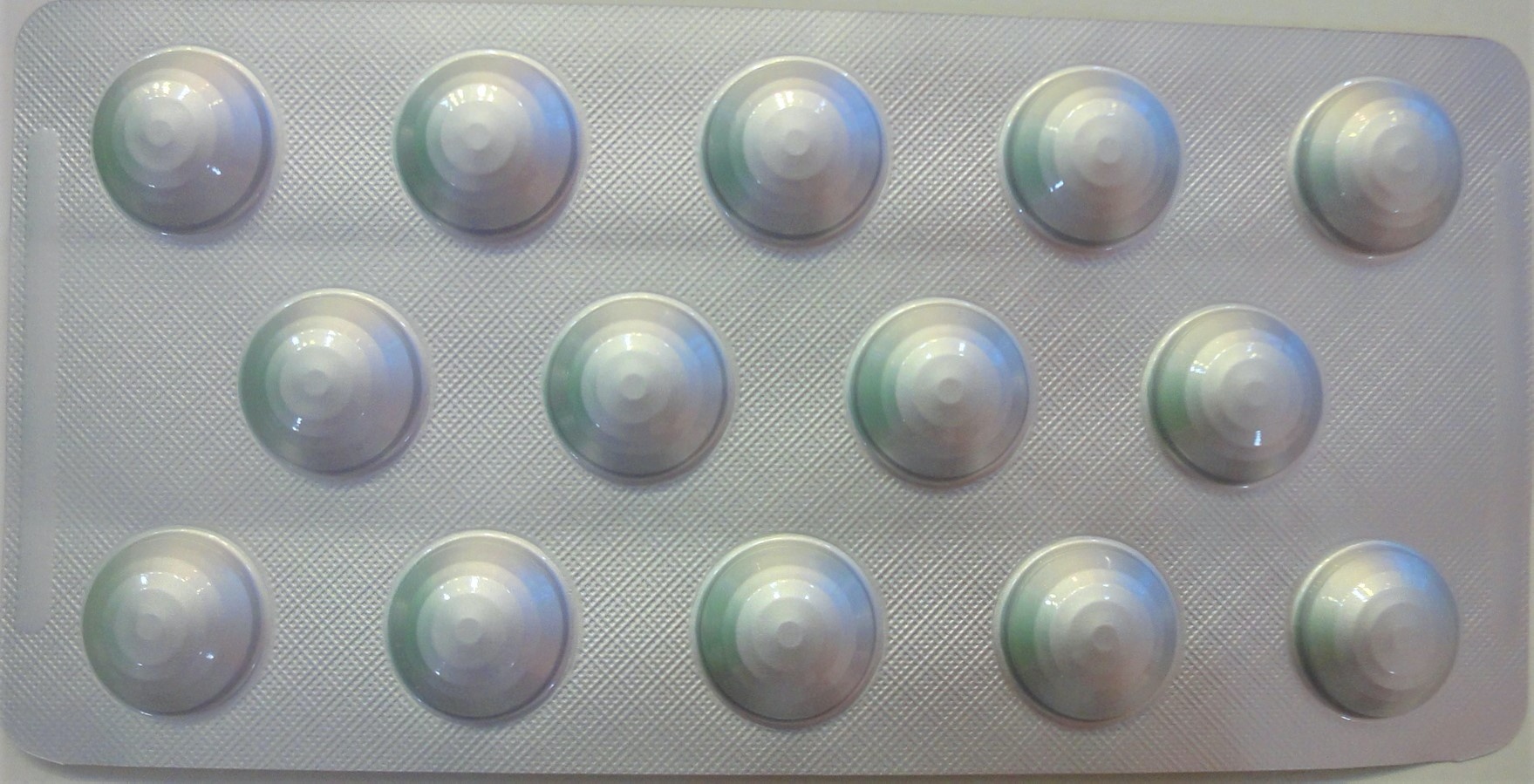CRESTOR Tablet
ក្រុមហ៊ុនផលិតឱសថ:
iPR Pharmaceuticals Inc. USA
ក្រុមហ៊ុនចែកចាយឱសថនៅប្រទេសកម្ពុជា:
DKSH


- សារធាតុសកម្ម
- ប្រសិទ្ធិភាពព្យាបាល និង កម្រិតប្រើប្រាស់
- ហាមប្រើ
- ផលរំខាន
- អន្តរប្រតិកម្ម
- ស្ត្រីមានផ្ទៃពោះ និង ស្ត្រីបំបៅដោះកូន
- ការប្រុងប្រយ័ត្នជាពិសេស
- សកម្មភាពឱសថ បរិយាយប័ណ្ណឱសថ
-
សារធាតុសកម្ម
1. CRESTOR 5mg Tablet:
Rosuvastatin 5mg
2. CRESTOR 10mg Tablet:
Rosuvastatin 10mg
3. CRESTOR 20mg Tablet:
Rosuvastatin 20mg
-
ប្រសិទ្ធិភាពព្យាបាល និង កម្រិតប្រើប្រាស់
គុណភាពព្យាបាល
ឱសថនេះប្រើជំនួយក្នុងការព្យាបាល:
- ជម្ងឺលើស Cholesterol ក្នុងឈាមក្នុងដំណាក់កាលដំបូងប្រភេទ IIa និង IIb រួមទាំង Heterozygous និង Homogygous familial Hypercholesterolaemia នៅពេលវិធីហាត់ប្រាណ តមអាហារគ្មានប្រសិទ្ធភាព។
កម្រិត និងរបៀបប្រើ
- មុននឹងព្យាបាល និងក្នុងអំឡុងពេលព្យាបាល អ្នកជម្ងឺលើសជាតិខ្លាញ់ ត្រូវទទួលទានអាហារណាដែលមានជាតិខ្លាញ់តិច។
- កម្រិតប្រើអាចប្រែប្រួល ទៅតាមទម្ងន់ដែលបុគ្គលម្នាក់ៗចង់បាន និងតាមផលវិបាកនៃការព្យាបាល
- កម្រិតប្រើចាប់ផ្ដើមគឺ 5-10មក្រ ក្នុង1ថ្ងៃ (លេបតែ1ដង) អាស្រ័យទៅតាមអត្រាជាតិខ្លាញ់ Cholesterol និងប្រតិកម្ម(ផលវិបាក)
- ឱសថនេះអាចប្រើនៅពេលណាក៏បាន (ជាមួយអាហារឬក៏ទេ)
- បន្ទាប់ពីបានប្រើ4សប្ដាហ៍ហើយ គេអាចកំណត់ថាតើត្រូវប្រើកំរិតប៉ុន្មានទើបសមស្រប តែការបង្កើនកំរិតប្រើ (40មក្រ) ជាទូទៅ ផ្ដល់នូវផលវិបាក (Adverse reaction) ច្រើនជាងការប្រើកំរិតខ្សោយ។
- កម្រិតប្រើ 40មក្រក្នុង1ថ្ងៃ ទុកប្រើចំពោះតែអ្នកមានជម្ងឺលើសជាតិខ្លាញ់ដែលអាចមានគ្រោះថ្នាក់ដល់សរសៃឈាមបេះដូងនិងអ្នកមានជម្ងឺលើសជាតិខ្លាញ់ប្រចាំត្រកូលឬតពូជ។
- អ្នកដែលប្រើកម្រិត 20មក្រក្នុង1ថ្ងៃ ហើយនៅតែមិនស្រក ហើយចង់ប្រើកម្រិត 40មក្រក្នុង1ថ្ងៃនោះ ត្រូវទៅពិគ្រោះជាមួយគ្រូពេទ្យនិងស្ថិតក្រោមការត្រួតពិនិត្យរបស់គ្រូពេទ្យ។
- គួរជៀសវាងប្រើចំពោះកុមារ។
- មនុស្សចាស់ និងអ្នកខ្សោយតម្រងនោមកម្រិតស្រាល និង មធ្យម អាចប្រើកម្រិតធម្មតាខាងលើ។Indications&Dosage
Primary hypercholesterolaemia (type Ⅱa including heterozygous familial hypercholesterolaemia) or mixed dyslipidaemia (type Ⅱb) as an adjunct to diet when response to diet and other non-pharmacological treatments (e.g. exercise, weight reduction) is inadequate.
Primary Dysbetalipoproteinemia (Type Ⅲ Hyperlipoproteinemia); this tablet is indicated as an adjunct to diet for the treatment of patients with primary dysbetalipoproteinemia (Type Ⅲ Hyperliproproteinemia)
Adjunctive therapy to diet for the treatment of adult patients with hypertriglyceridaemia.
Homozygous familial hypercholesterolaemia as an adjunct to diet and other lipid lowering treatments (e.g. LDL apheresis) or if such treatments are not appropriate.
Pediatric Patients 10-17 years of age with Heterozygous Familial Hypercholesterolemia (HeFH): Adjunct to diet to reduce Total-C, LDL-C and ApoB levels in adolescent boys and girls, who are at least one year post-menarche, 10-17 years of age with heterozygous familial hypercholesterolemia if after an adequate trial of diet therapy the following findings are present: LDL-C > 190mg/dL or >160mg/dL and there is a positive family history of premature cardiovascular disease (CVD) or two or more other CVD risk factors.
Adjunctive therapy to diet to slow the progression of altherosclerosis in adult patients as part of a treatment strategy to lower Total-C and LDL-C to target levels.
Primary Prevention of Cardiovascular Disease:
In individuals without clinically evident coronary heart disease but with an increased risk of cardiovascular disease based on age ≥50 years old in men and ≥60 years old in women, hsCRP≥2mg/dL, and the presence of at least one additional cardiovascular disease risk factor such as hypertension, low HDL-C, smoking, or a family history of premature coronary heart disease, this tablet is indicated to:
- reduce the risk of stroke,
- reduce the risk of myocardial infarction,
- reduce the risk of arterial revascularization procedures
Limitations of Use: this tablet has not been studied in Fredrickson Type Ⅰ and Ⅴ dyslipidemias.
Dosage and Administration
Before treatment initiation the patient should be placed on a standard cholesterol-lowering diet that should continue during treatment. The dose should be individualized according to the goal of therapy and patient response, using current consensus guidelines.
The recommended start dose is 5-10mg once daily.
If necessary, the dose could be adjusted according to the individual demand and response by increasing to next dose level after not less than 4 weeks.
The maximum dose is 40mg.
Crestor may be given at any time of day, with or without food.
Paediatric use
Heterozygous Familial Hypercholesterolemia in Pediatric Patients (10-17 years of age):
The usual dose range is 5-20mg/day; the maximum recommended dose is 20mg/day (doses greater than 20mg have not been studied in this patient population). Doses should be individualized according to the recommended goal of therapy. Adjustments should be made at intervals of 4 weeks or more.
Homozygous familial hypercholesterolaemia: Paediatric experience is limited to a small number of children (aged 8 years or above).
Use in elderly
No dose adjustment is necessary.
Dosing in patients with renal insufficiency
No dose adjustment is necessary in patients with mild to moderate renal impairment. The use in patients with severe renal impairment is contraindicated.
Dosing in patients with hepatic impairment
There was no increase in systemic exposure to rosulvastatin in subjects with Child-Pugh scores of 7 or below. However, increased systemic exposure has been observed in subjects with Child-Pugh scores of 8 and 9. In these patients an assessment of renal function should be considered. There is no experience in subjects with Child-Pugh scores above 9. Crestor is contraindicated in patients with active liver disease.
Dosing in Asian Patients
In Asian patients, consider initiation of CRESTOR therapy with 5mg once daily due to increased rosuvastatin plasma concentrations. The increased systemic exposure should be taken into consideration when treating Asian patients not adequately controlled at doses up to 20mg/day.
Use with Concomitant Therapy
Patients taking cyclosporine
The dose should not exceed 5mg once daily.
Patients taking gemfibrozil
Initiate CRESTOR therapy with 5mg once daily. The dose should not exceed 10mg once daily.
Patients taking lopinavir and ritonavir or atazanavir and ritonavir
Initiate CRESTOR therapy with 5mg once daily. The dose should not exceed 10mg once daily.
-
ហាមប្រើ
ហាមប្រើ ចំពោះ
- អ្នកធ្លាប់មានប្រតិកម្មជាមួយសារធាតុផ្សំណាមួយនៃឱសថនេះ។
- អ្នកមានជម្ងឺថ្លើមកំពុងវិវឌ្ឈន៍ ពោលគឺ Transaminase លើសពីកម្រិតធម្មតា 3ដង ហើយនៅថេរមិនធ្លាក់ចុះវិញ។
- អ្នកមានជម្ងឺមុខងារតម្រងនោមខ្សោយធ្ងន់ធ្ងរ (Creatinine តិចជាង 30មល/នាទី)
- អ្នកជម្ងឺដែលទទួលឱសថ Cyclosporin ក្នុងពេលតែមួយ
- ស្ត្រីមានផ្ទៃពោះ និង ស្ត្រីបំបៅកូន។
- in patients with hypersensitivity to rosuvastatin or to any of the excipients.
- in patients with active liver disease including unexplained, persistent elevations of serum transaminases and any serum transaminase elevation exceeding 3the upper limit of normal (ULN).
- in patients with severe renal impairment (creatinine clearance <30ml/min).
- in patients with myopathy.
- in patients receiving concomitant cyclosporin.
- during pregnancy and lactation and in women of childbearing potential not using appropriate contraceptive measures.
-
ផលរំខាន
ផលវិបាក
មានលក្ខណៈខ្សោយនិងបណ្ដោះអាសន្នដូចជា ឈឺក្បាល វិលមុខ ឈឺពោះ ឈឺសាច់ដុំ។ ករណីកម្រអាចមាន រមាស់ ជាំស្បែក ឡើងកន្ទាលត្រអាក ។ល។hypersensitivity reactions including angioedema, headache, dizziness, constipation, nausea, abdominal pain, pancreatitis, pruritus, rash, urticaria, myalgia, myopathy, rhabdomyolysis, asthenia.
As with other HMG-CoA reductase inhibitors, the incidence of adverse drug reactions tends to be dose dependent.
-
អន្តរប្រតិកម្ម
Cyclosporine, Gemfibrozil, Protease Inhibitors, Coumarin anticoagulants, Niacin, Fenofibrate, Colchicine.
-
ស្ត្រីមានផ្ទៃពោះ និង ស្ត្រីបំបៅដោះកូន
ហាមប្រើចំពោះស្ត្រីមានផ្ទៃពោះ និង ស្ត្រីបំបៅកូន។
Crestor is contraindicated in pregnancy and lactation.
Women of child bearing potential should use appropriate contraceptive measures.
Rosuvastatin is excreted in the mild of rats. There are no data with respect to excretion in milk in humans.
-
ការប្រុងប្រយ័ត្នជាពិសេស
ការប្រុងប្រយ័ត្ន
- អ្នកជម្ងឺដែលប្រើកម្រិតខ្ពស់ (40មក្រ) ត្រូវធ្វើការពិនិត្យមុខងារតម្រងនោម។
- ត្រូវប្រុងប្រយ័ត្នប្រើឱសថនេះ ចំពោះអ្នកមានមុខងារតម្រងនោមខ្សោយ អ្នកមានជម្ងឺខ្សោយក្រពេញThyroidism អ្នកមានវិបត្តិសាច់ដុំតពូជ អ្នកប្រមឹកសុរា មនុស្សចាស់អាយុលើសពី70ឆ្នាំ អ្នកប្រើឱសថFibrateក្នុងពេលតែមួយ អ្នកមានជម្ងឺថ្លើម។Renal Effects
Skeletal Muscle Effects
Race
Endocrine Effects
Protease inhibitors
Pediatric Use
-
សកម្មភាពឱសថ
Rosuvastatin is a selective and competitive inhibitor of HMG-CoA reductase, the rate-limiting enzyme that converts 3-hydroxy-3-methylglutaryl coenzyme A to mevalonate, a precursor for cholesterol. The primary site of action of rosuvastatin is the liver, the target organ for cholesterol lowering.
Rosuvastatin increases the number of hepatic LDL receptors on the cell-surface, enhancing uptake and catabolism of LDL and it inhibits the hepatic synthesis of VLDL, thereby reducing the total number of VLDL and LDL particies.
*ព័ត៌មានឱសថត្រូវបានរៀបរៀងដោយ អ៊ីម៉ាតុគឹ មេឌីក (ខេមបូឌា) ដោយផ្អែកលើប្រភពព័ត៌មានខាងក្រោម។ សម្រាប់ព័ត៌មានលម្អិត សូមស្វែងរកនៅក្នុងក្រដាសព័ត៌មាននៃឱសថនីមួយៗ ឬ សាកសួរទៅកាន់ក្រុមហ៊ុនឱសថឬតំណាងចែកចាយនៃឱសថនីមួយៗ។
ប្រភពព័ត៌មាន៖
- ក្រដាសព័ត៌មាននៃឱសថសម្រាប់អ្នកជំនាញវេជ្ជសាស្ត្រដែលប្រើប្រាស់នៅប្រទេសជប៉ុន (Pharmaceutical and Medical Devices Agency, Pmda): https://www.pmda.go.jp
- ព័ត៌មានសង្ខេបនៃឱសថសម្រាប់អ្នកជំងឺដែលប្រើប្រាស់នៅប្រទេសជប៉ុន: http://www.rad-ar.or.jp
